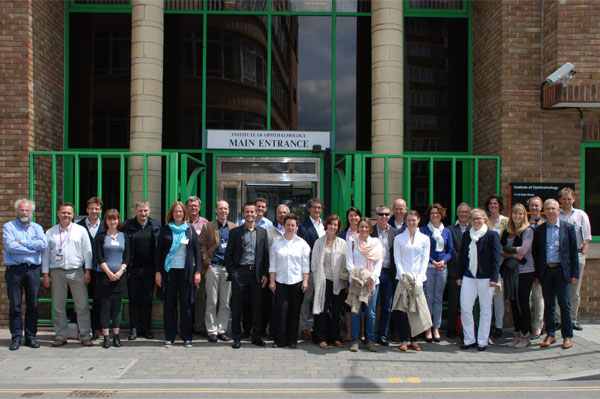The Barcelona Macula Foundation, one of the Research Sites of the European Horizon 2020 Research Consortium on AMD, The EYE-RISK Project

The Barcelona Macula Foundation: Research for Vision is one of the 8 international Research Centers, two companies and one patient organisation of this European Horizon 2020 Research Consortium, exploring the combined role of genetic and non-genetic factors for developing AMD: A systems level analysis of disease subgroups, risk factors, and pathways, The EYE-RISK Project. The EYE-RISK project has received funding from the European Union’s Horizon 2020 research and innovation programme under grant agreement No 634479.
The main objectives of EYE-RISK are:
1. Determination of AMD frequency in Europe, and assessment of AMD risk for phenotypical, genetic, environmental, and biochemical risk factors and their interaction.
2. Development of a web-based prediction model for personalised risk assessment of AMD based on integration of risk profiles derived from retinal imaging, molecular genetics, assessment of lifestyle, and biochemical testing.
3. Modelling and functional characterisation of pathophysiological pathways identified from integrated analysis of current knowledge and the above risk profiles.
4. Experimental testing and interpretation of pathophysiological consequences of risks at the molecular level.
5. An extension and refinement of the prediction model obtained based on this research to generate clinical guidelines for the medical management of high-risk subgroups of patients with AMD.
6. Promotion and dissemination of newly gained knowledge towards AMD prevention and therapy development.
Age-related macular degeneration (AMD) is a persistent, progressive and incurable complex disease leading to declining sight that progresses to complete loss of vision. Susceptibility is determined by a combination of aging, genetic risks and environmental factors.
Today the EU has 91 million people above the age of 65y and this number is projected to grow to 127 million by 2020 (Eurostat). AMD is the world’s most important age-related blinding disorder and aging eye disease. It is estimated that globally 196 million people will have AMD in 2020, increasing to 288 million in 2040. Prevalence of late stage AMD increases with age and is at 1.5 to 3.5% in European populations above age 65y, affecting 18 million individuals in Europe. Specifically regarding the untreatable form of AMD, the geographic atrophy, may affect more than 20% of individuals of 85 years old. AMD is among the 15 causes of disability with the largest burden increase in the last 20 years and AMD is the leading cause of blindness in the western world. Quality of life measured in AMD patients is similar to the quality of life reported in patients with stroke, severe cardiovascular disease or cancer.
The EYE-RISK Project will exploit the comprehensive epidemiologic data and biosamples from large European epidemiologic eye cohorts and biobanks (total study population N=100,000) to develop a clinical prediction tool for AMD, to characterise risk profiles individualised to subgroups of AMD patients, and to identify disease mechanisms occurring at the molecular level. This research will specify who is at risk of developing AMD, who is at risk for progression, why and how risks combine to advance progression in specific patients and what we can do to lower their risk. The ultimate aim of this proposal is to create new clinical guidelines based on molecular signatures for AMD and new targets for prevention and therapy based on an in-depth understanding of pathogenetic drivers.
The investigators of the Barcelona Macula Foundation: Research for Vision (BMF), leaded by Jordi Monés MD, PhD as Principal Investigator, will play a major role at different stages of the Project as clinical research experts in the consortium.
On 23-24 June, the Kick-Off Meeting of EYE-RISK took place in London. During the meeting, the strategy, work packages, and set aims were reviewed. In addition, working groups were set up in order to draw up the lines for the forthcoming months of research. The Barcelona Macula Foundation will be involved in most work packages (WPs), and most specifically in the search for sub-groups of patients with certain clinical characteristics of fundus features (named “phenotypes”) both in the exudative and atrophic form. These enable, among other aspects, to differentiate rapid progressors suffering from geographic atrophy from slow ones and therefore identify those patients who may benefit most from their inclusion in new clinical trials, which are in progress throughout the world, or anticipate which patients will be more likely to convert to the advanced stages of the disease. Other outcomes will be to anticipate which patients are likely to be good or by the contrary poor responders to the current therapies, and also to establish hypothesis for new potential therapeutical approaches. The meeting was attended by two representatives of the BMF who actively participated in the planning and coordination of further steps, Dr. Jordi Monés MD, PhD, retina and macula specialist and researcher and the Medical Director of the BMF; and Dr. Marc Biarnés, PhD in Biomedicine and epidemiology, and Coordinator of Clinical Trials.
As Dr. Jordi Monés stated “EYERISK will deliver new knowledge on the mechanism of development and progression of the different forms of this devastating disease, generating essential tools for innovative discovery and development of future new drugs targets for AMD and better design of clinical trials.”
EYE-RISK comprises 8 Research Centers from European 6 countries, two companies and one patient organisation. All the entities participating in the project will conduct research to determine the frequency of Age-Related Macular Degeneration in Europe, discover the risk factors that may cause it and develop a web-based prediction model for personalized AMD risk assessment.

